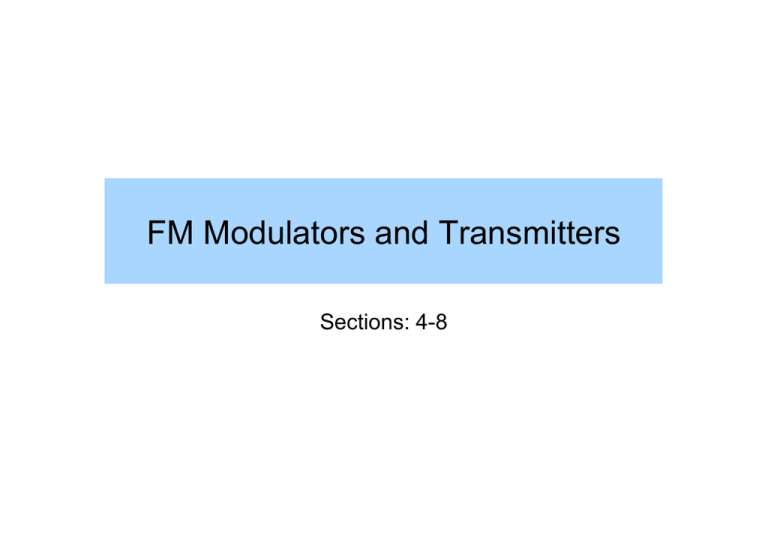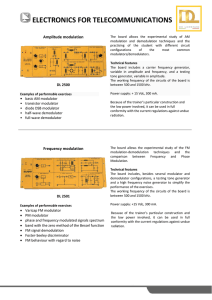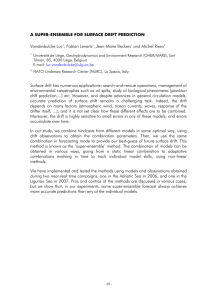FM transmitters
advertisement

FM Modulators and Transmitters Sections: 4-8 Outline • • • FM modulators and transmitters Frequency drifting; ppm Basic component review Angle Modulation Classification • Direct PM Modulation Techniques – – – – Indirect FM Phase of the carrier changes according to m(t) Thus, Indirect FM Modulation – Advantages of direct PM: Uses stable crystal oscillator Disadvantages of direct PM: Limited phase deviation\ • Indirect PM Modulation Techniques Direct FM – Direct FM Modulation - frequency of the carrier changes according to m(t) – Advantages of direct FM: easy to obtain high frequency deviation – Disadvantages of direct FM: when using LC tanks it is not very stable, thus additional circuitry is required – Approaches to create direct FM: • Varactor diode modulators • FM reactance modulators • IC-based modulators See notes for diagrams FM Transmitters • Direct – Crosby – utilizing AFC loop (automatic frequency control loop) – PLL- based • Indirect – Armstrong – FM transmitter using PM modulators FM Transmitters/Receiver – Key Components (review) • Linear and non-linear devices • Discriminators – Frequency to amplitude converters – Differentiators • • • • • Multipliers Dividers Mixers Phase detectors Oscillators – Tank circuits (LC) – Varactor diodes • • • • • Adders Bandpass Limiters Envelop detectors VCOs Filters – RC (LPF, HPF) – LRC (Bandpass Filter) – All-pass filters • • • • Amplifiers PLL Super-heterodyning Preemphasis and Deemphasis Filters • Devices which take input waveform and modify its frequency spectrum content • Use energy storage elements to obtain frequency discrimination – Inductors – Capacitors • They have different classifications: – Construction • LC elements • Quartz crystal elements – Transfer function response • Butterworth, Chebyshev • Filters contain energy storage elements that are physically imperfect – Inductors have resistance – Capacitors have shunt resistance à leakage • The quality of these elements can be measured using Quality Q of the filter • Two ways of calculation: – Q = 2pi (maximum energy stored during on cycle)/Energy dissipated per cycle – Q = fo/B (B is 3-dB BW; and fo is resonant freq. • For LRC circuits we use Q = fo/B – The more narrowband the filter the larger the Q à less DRIFT! Filter Construction Filter Constructions Active filters using OPAMPS are limited to 500KHz – opamps have large open-loop gain! Lumped LC elements are impractical above 300MHz – Low Q Crystal filters using quartz crystal elements are good up to 100 MHz, good stability high Qà very good performance à low drift à more expensive than RC FM Transmitters – Crosby Direct FM • • • Used for commercial broadcast-band transmitters Uses an Automatic Frequency Control (AFC) Loop Characteristics: – – – – – Phase deviation of the output is multiple of phase deviation of the modulator The modulating frequency is unaffected by the multiplication process The angle modulated carrier is heterodyned through the non-linear mixer The output of the mixer depends on the passband filter – could be up/down converted Discriminator generally has high-Q (narrowband) Master Frequency modulator (fc) DC correction voltage is added to the modulator to adjust the fc due to any DRIFT Crystal Oscillator To the antenna Non-linear mixer Note: Kd is in V/Hz Ko is in Hz/V FM Transmitters - Example • • • Assume fc drift 40 ppm/degree (40 x 5.1 = +/- 204Hz) à 3672 Hz at the antenna; Thus, following 5 degree temp. change à freq. drift will be 18.36 KHz at the antenna! In this case the open-loop drift is dfopen = N1.N2.dfc. Master Frequency modulator (fc) To the antenna Max. frequency deviation allowed by FCC is 2KHz Note that frequency drifting can occur due to temperature change. It is often given in ppm per deg.Non-linear C. mixer Example: A drift of 40 ppm at the master oscillator will translate to DC correction voltage is added to the modulator to adjust the fc due [(40ppm x 5.1)/10^6] = +/- 204Hz=Δf) to any DRIFT Similarly, Note: Δf=204 Hz à [(Δf/fc)*10^6] = 200 ppm Kd is in V/Hz Ko is in Hz/V Crystal Oscillator FM Transmitters – Example w/AFC • • • Assume fc drift 40 ppm (40 x 5.1 = +/- 204Hz) & Assuming KdKo=3.83 In this case the closed-loop drift is dfclosed = dfopen/(1 + N1.N2.Kd.Ko). Thus, the total drift at the antenna will be 153 Hz (51 Hz before the antenna). Much less than before To the antenna Max. frequency deviation allowed by FCC is 2KHz Master Frequency modulator (fc) Non-linear mixer DC correction voltage is added to the modulator to adjust the fc due to any DRIFT Note: Kd is in V/Hz Ko is in Hz/V Crystal Oscillator FM Transmitters – Example w/AFC • • • What if the discriminator and crystal reference oscillator drift as well? In this case the closed-loop drift is dfclosed = dfopen/(1 + N1.N2.Kd.Ko). The total open-loop drift will be: dfopen = N1.N2(dfc + .Kd.Ko.dfd + Kd.Ko.N4.dfo ) Master Frequency modulator (fc) To the antenna Max. frequency deviation allowed by FCC is 2KHz Typical Values: Discriminators: +/- 100 ppm Note that had we not used the Mixer, the drift at the output of the discriminator would have been 100ppm*30.6 = 3060 Hz as opposed to 100ppmx2 = 200Hz!! DC correction voltage is added to the modulator to adjust the fc due to any DRIFT Note: Kd is in V/Hz Ko is in Hz/V Crystal Oscillator Direct FM Transmitter Using PLL • Generating WBFM (large ΔF) ; we assume the stability of the VCO (carrier) is not very good à we use PLL • The stability of the crystal oscillator is relatively good and has high –Q ac ac Phase detector dc Good stability; Lower frequency DC Voltage Correction fc Indirect WBFM (Armstrong Method) • Uses NBFM to generate WBFM • The NBFM is generated using indirect method WBFM Using Indirect Method of Armstrong • • • Two blocks: Mixer and Modulator Note that the output of NBFM is à Utilizes heterodyning and up-conversion WBFM Using Indirect Method of Armstrong s(t) = Vc cos(ω c t + θ (t)) sPM (t) = Vc cos(ω c t + Dp m(t)) Low ΔF=25 Hz fm Max 15KHz Modulation index: ΔF/fm sFM (t) = Vc cos(ω c t + ∫ D m(τ )dτ ) f Can lead Or lag Low Freq. Carrier / High Q Heterodyned Must be 88-108 MHz For commercial FM Also called the balanced modulator WBFM Using Indirect Method of Armstrong s(t) = Vc cos(ω c t + θ (t)) Questions: Calculate the min. modulation index. How do you create NBPM? fm Max 15KHz Low ΔF=25 Hz sPM (t) = Vc cos(ω c t + Dp m(t)) Modulation index: ΔF/fm sFM (t) = Vc cos(ω c t + ∫ D m(τ )dτ ) f Can lead or lag Low Freq. Carrier / High Q Heterodyned Must be 88-108 MHz For commercial FM Also called the balanced modulator References • Leon W. Couch II, Digital and Analog Communication Systems, 8th edition, Pearson / Prentice, Chapter 4 • Signal Conditioning: An Introduction to Continuous Wave Communication By Apurba Das, Chapter 5 • Contemporary Communication Systems, First Edition by M F Mesiya– Chapter 5 • See Notes (http://highered.mcgraw-hill.com/sites/0073380369/information_center_view0/)



